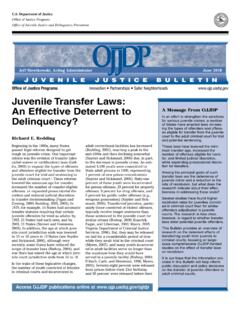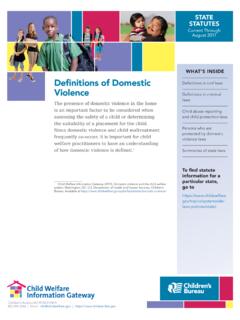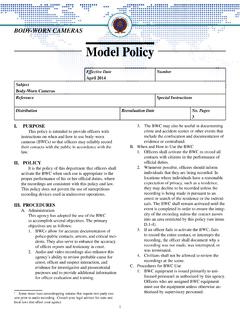Transcription of Juveniles in Adult Prisons and Jails - Office of Justice ...
1 A National AssessmentBureau of Justice AssistanceJuveniles in AdultPrisons and department of JusticeOffice of Justice ProgramsBureau of Justice AssistanceMonographThis document was prepared by the Institute on Crime, Justice and Corrections and theNational Council on Crime and Delinquency, under grant number 97 DD BX 0026, awardedby the Bureau of Justice Assistance, Office of Justice Programs, department of opinions, findings, and conclusions or recommendations expressed in this documentare those of the authors and do not necessarily represent the official position or policies ofthe department of department of JusticeOffice of Justice Programs810 Seventh Street , DC 20531 Janet RenoAttorney GeneralDaniel MarcusActing Associate Attorney GeneralMary Lou LearyActing Assistant Attorney GeneralNancy E.
2 GistDirector, Bureau of Justice AssistanceOffice of Justice ProgramsWorld Wide Web Home of Justice AssistanceWorld Wide Web Home grant and funding information department of Justice Response Center1 800 421 6770 The Bureau of Justice Assistance is a component of the Office of Justice Programs, which alsoincludes the Bureau of Justice Statistics, the National Institute of Justice , the Office of JuvenileJustice and Delinquency Prevention, and the Office for Victims of of Justice AssistanceJuveniles in AdultPrisons and JailsA National AssessmentMonographOctober 2000 NCJ 182503 James Austin, Dedel Johnson, Gregoriou, on Crime, Justice and Correctionsat The George Washington UniversityandNational Council on Crime and DelinquencyiiiJuveniles in Adult Prisons and JailsForewordSince 1992, 45 states have passed or amended legislation making it easierto prosecute Juveniles as adults.
3 The result is that the number of youth un-der 18 confined in Adult Prisons has more than doubled in the past phenomenon is challenging the belief, enshrined in our Justice systema century ago, that children and young adolescents should be adjudicatedand confined in a separate system focused on their 1997, the Bureau of Justice Assistance funded a nationwide study of ju-veniles in Adult correctional facilities to help policymakers and criminaljustice practitioners form an effective response to this critical issue. Juve-niles in Adult Prisons and Jails : A National Assessment is the product of thatstudy.
4 This report begins to answer important questions about this vulner-able population: What is the extent of juvenile confinement in federal,state, and local facilities? What types of facilities are used to house juvenileoffenders? What happens to Juveniles in the Adult system? Are Juveniles inadult facilities educated, treated for substance abuse, and taught skills thatwill help them find a job after their incarceration? Are Prisons and jailsprotecting young offenders from physical, sexual, and psychologicalabuse? What are the alternative strategies for housing offenders sentencedto long terms in Adult facilities?
5 As the findings of this study show, there are important steps we can takenow to improve the well-being of juvenile offenders in Adult facilities. Wecan develop specialized vocational, sex offender, and substance abuse pro-grams tailored to the developmental needs of youth. We can ensure thatstaff in Adult facilities take seriously their federal mandate to provideregular and special education services to youth in their care. And we cando much more to ensure the safety and care of young offenders who inter-act with Adult is our hope that this work engages public officials, administrators,judges, prosecutors, public defenders, scholars, and other criminal justicepractitioners in a frank and meaningful discussion about the incarcerationof Juveniles with E.
6 GistDirectorBureau of Justice AssistancevJuveniles in Adult Prisons and JailsContentsExecutive ixHistorical Context of the Study .. ixStudy Objectives .. xMajor Findings .. xRecommendations .. xiChapter 1 1 Background to the Study .. 1 Historical Trends in the Number of Youth Confinedin Adult Facilities .. 4 Conditions of Confinement .. 7 Policy Issues Addressed by the Study .. 8 Overview of the Report .. 9 Chapter 2 Legal Issues Relating to Conditions of Confinementfor Youth in Adult 11 Introduction .. 11 Issues Arising in Institutional Litigation .. 13 Classification.
7 13 Health .. 15 Access .. 17 Programming .. 19 Training .. 20 Environment .. 21 Restraints .. 24 Safety .. 26 State Statutes and juvenile Transfer Laws .. 27 Law Case Citations .. 29 Chapter 3 Characteristics of Juveniles Housed inAdult Jails and 35 Introduction .. 35viBureau of Justice AssistanceFindings .. 36 Correctional System Survey Findings .. 36 Facility Survey Findings .. 43 Summary .. 45 Chapter 4 Management 47 Introduction .. 47 Arizona department of Corrections .. 47 Florida department of Corrections .. 52 Virginia department of Corrections .. 56 New York City department of Corrections.
8 58 Philadelphia department of Corrections .. 61 Major Findings .. 63 Chapter 5 Alternative Strategies and Technical 65 Classification Systems .. 65 Staff and Staff Training .. 66 Programming .. 66 Education .. 67 Behavior Management Techniques .. 68 Housing Strategies .. 68 Continued Research .. 68 AppendixState Statutes That Govern the Transferof Juveniles to the Adult Court 125 Sources for Further 127viiJuveniles in Adult Prisons and JailsTables and FiguresFiguresFigure 1 juvenile Arrest Rates for Violent Crime IndexOffenses, Ages 10 17, 1981 2 Figure 2 Delinquency Cases Judicially Waived to CriminalCourt, 1987 3 TablesTable 1 Number of Juveniles Incarcerated, 4 Table 2 Juveniles in Adult Jails , 1983 5 Table 3 Attributes of Juveniles Admitted to State Prisons .
9 1985 and 6 Table 4 State Systems That Maintain Separate HousingUnits for Incarcerated 37 Table 5 State Prison Populations, Youth and Adult , 38 Table 6 Future Housing Expansion Plans forYouthful 39 Table 7 Characteristics of State Prison Inmates, 40 Table 8 Age of Youthful Offender Population, 41 Table 9 juvenile Population Movement Patterns, 42 Table 10 Programs Offered by Adult CorrectionalSystems to Youthful Offenders, 42 Table 11 Characteristics of Correctional FacilitiesResponding to Facility 44 Table 12 Characteristics of Facilities Selected for Site 48ixJuveniles in Adult Prisons and JailsExecutive SummaryHistorical Context of the StudyThe development of a distinct Justice system tailored to recognize the miti-gating factors associated with juvenile crime is recognized as one of themost progressive developments in the evolution of criminal Justice in theUnited States.
10 Until the 20th century, no formal differentiation had beenmade between society s response to crimes committed by Juveniles and itsresponse to crimes committed by adults. Beginning in Illinois in 1899, juve-nile court systems were instituted throughout the United States to placegreater emphasis on the welfare and rehabilitation of youth in the justicesystem. Specialized detention centers, training schools, and youth centerswere developed to confine and treat delinquent youth apart from Adult of-fenders. These facilities were to provide a structured, rehabilitative envi-ronment in which the educational, psychological, and vocational needs ofyouthful offenders could be addressed.














